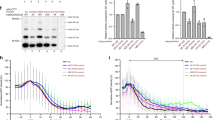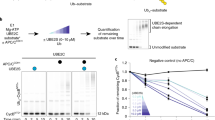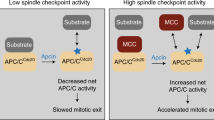Abstract
The anaphase-promoting complex/cyclosome (APC) is a ubiquitin ligase that is required for exit from mitosis. We previously showed that tosyl arginine methyl ester (TAME) inhibits APC-dependent proteolysis by competing with the C-terminal isoleucine-arginine tail of the APC activator cell division cycle 20 (Cdc20) for APC binding. Here we show that in the absence of APC substrates, TAME ejects Cdc20 from the APC by promoting Cdc20 autoubiquitination in its N-terminal region. Cyclin B1 antagonizes TAME's effect by promoting binding of free Cdc20 to the APC and by suppressing Cdc20 autoubiquitination. Nevertheless, TAME stabilizes cyclin B1 in Xenopus extracts by two mechanisms. First, it reduces the kcat of the APC-Cdc20–cyclin B1 complex without affecting the Km, slowing the initial ubiquitination of unmodified cyclin B1. Second, as cyclin B1 becomes ubiquitinated, it loses its ability to promote Cdc20 binding to the APC in the presence of TAME. As a result, cyclin B1 ubiquitination terminates before reaching the threshold necessary for proteolysis.
This is a preview of subscription content, access via your institution
Access options
Subscribe to this journal
Receive 12 print issues and online access
$259.00 per year
only $21.58 per issue
Buy this article
- Purchase on Springer Link
- Instant access to full article PDF
Prices may be subject to local taxes which are calculated during checkout







Similar content being viewed by others
References
Peters, J.M. The anaphase promoting complex/cyclosome: a machine designed to destroy. Nat. Rev. Mol. Cell Biol. 7, 644–656 (2006).
Verma, R. et al. Ubistatins inhibit proteasome-dependent degradation by binding the ubiquitin chain. Science 306, 117–120 (2004).
Zeng, X. et al. Pharmacologic inhibition of the anaphase-promoting complex induces a spindle checkpoint-dependent mitotic arrest in the absence of spindle damage. Cancer Cell 18, 382–395 (2010).
Pesin, J.A. & Orr-Weaver, T.L. Regulation of APC/C activators in mitosis and meiosis. Annu. Rev. Cell Dev. Biol. 24, 475–499 (2008).
Hayes, M.J. et al. Early mitotic degradation of Nek2A depends on Cdc20-independent interaction with the APC/C. Nat. Cell Biol. 8, 607–614 (2006).
Kimata, Y., Baxter, J.E., Fry, A.M. & Yamano, H. A role for the Fizzy/Cdc20 family of proteins in activation of the APC/C distinct from substrate recruitment. Mol. Cell 32, 576–583 (2008).
da Fonseca, P.C. et al. Structures of APC/C(Cdh1) with substrates identify Cdh1 and Apc10 as the D-box co-receptor. Nature 470, 274–278 (2011).
Thornton, B.R. et al. An architectural map of the anaphase-promoting complex. Genes Dev. 20, 449–460 (2006).
Passmore, L.A. et al. Doc1 mediates the activity of the anaphase-promoting complex by contributing to substrate recognition. EMBO J. 22, 786–796 (2003).
Vodermaier, H.C., Gieffers, C., Maurer-Stroh, S., Eisenhaber, F. & Peters, J.M. TPR subunits of the anaphase-promoting complex mediate binding to the activator protein CDH1. Curr. Biol. 13, 1459–1468 (2003).
Burton, J.L. & Solomon, M.J. D box and KEN box motifs in budding yeast Hsl1p are required for APC-mediated degradation and direct binding to Cdc20p and Cdh1p. Genes Dev. 15, 2381–2395 (2001).
Hilioti, Z., Chung, Y.S., Mochizuki, Y., Hardy, C.F. & Cohen-Fix, O. The anaphase inhibitor Pds1 binds to the APC/C-associated protein Cdc20 in a destruction box-dependent manner. Curr. Biol. 11, 1347–1352 (2001).
Kraft, C., Vodermaier, H.C., Maurer-Stroh, S., Eisenhaber, F. & Peters, J.M. The WD40 propeller domain of Cdh1 functions as a destruction box receptor for APC/C substrates. Mol. Cell 18, 543–553 (2005).
Schwab, M., Neutzner, M., Mocker, D. & Seufert, W. Yeast Hct1 recognizes the mitotic cyclin Clb2 and other substrates of the ubiquitin ligase APC. EMBO J. 20, 5165–5175 (2001).
Buschhorn, B.A. et al. Substrate binding on the APC/C occurs between the coactivator Cdh1 and the processivity factor Doc1. Nat. Struct. Mol. Biol. 18, 6–13 (2011).
Burton, J.L., Tsakraklides, V. & Solomon, M.J. Assembly of an APC-Cdh1–substrate complex is stimulated by engagement of a destruction box. Mol. Cell 18, 533–542 (2005).
Eytan, E., Moshe, Y., Braunstein, I. & Hershko, A. Roles of the anaphase-promoting complex/cyclosome and of its activator Cdc20 in functional substrate binding. Proc. Natl. Acad. Sci. USA 103, 2081–2086 (2006).
Matyskiela, M.E. & Morgan, D.O. Analysis of activator-binding sites on the APC/C supports a cooperative substrate-binding mechanism. Mol. Cell 34, 68–80 (2009).
Dimova, N. et al. APC/C-mediated multiple monoubiquitination provides an alternative degradation signal for cyclin B1. Nat. Cell Biol 14, 168–176 (2012).
Townsley, F.M., Aristarkhov, A., Beck, S., Hershko, A. & Ruderman, J.V. Dominant-negative cyclin-selective ubiquitin carrier protein E2-C/UbcH10 blocks cells in metaphase. Proc. Natl. Acad. Sci. USA 94, 2362–2367 (1997).
Reddy, S.K., Rape, M., Margansky, W.A. & Kirschner, M.W. Ubiquitination by the anaphase-promoting complex drives spindle checkpoint inactivation. Nature 446, 921–925 (2007).
Stegmeier, F. et al. Anaphase initiation is regulated by antagonistic ubiquitination and deubiquitination activities. Nature 446, 876–881 (2007).
Nilsson, J., Yekezare, M., Minshull, J. & Pines, J. The APC/C maintains the spindle assembly checkpoint by targeting Cdc20 for destruction. Nat. Cell Biol. 10, 1411–1420 (2008).
Kirkpatrick, D.S. et al. Quantitative analysis of in vitro ubiquitinated cyclin B1 reveals complex chain topology. Nat. Cell Biol. 8, 700–710 (2006).
Garnett, M.J. et al. UBE2S elongates ubiquitin chains on APC/C substrates to promote mitotic exit. Nat. Cell Biol. 11, 1363–1369 (2009).
Williamson, A. et al. Identification of a physiological E2 module for the human anaphase-promoting complex. Proc. Natl. Acad. Sci. USA 106, 18213–18218 (2009).
Wu, T. et al. UBE2S drives elongation of K11-linked ubiquitin chains by the anaphase-promoting complex. Proc. Natl. Acad. Sci. USA 107, 1355–1360 (2010).
Pierce, N.W., Kleiger, G., Shan, S.O. & Deshaies, R.J. Detection of sequential polyubiquitylation on a millisecond timescale. Nature 462, 615–619 (2009).
Rape, M., Reddy, S.K. & Kirschner, M.W. The processivity of multiubiquitination by the APC determines the order of substrate degradation. Cell 124, 89–103 (2006).
Kim, H.S. et al. SIRT2 maintains genome integrity and suppresses tumorigenesis through regulating APC/C activity. Cancer Cell 20, 487–499 (2011).
Varetti, G., Guida, C., Santaguida, S., Chiroli, E. & Musacchio, A. Homeostatic control of mitotic arrest. Mol. Cell 44, 710–720 (2011).
Ge, S., Skaar, J.R. & Pagano, M. APC/C- and Mad2-mediated degradation of Cdc20 during spindle checkpoint activation. Cell Cycle 8, 167–171 (2009).
Pan, J. & Chen, R.H. Spindle checkpoint regulates Cdc20p stability in Saccharomyces cerevisiae. Genes Dev. 18, 1439–1451 (2004).
Mansfeld, J., Collin, P., Collins, M.O., Choudhary, J.S. & Pines, J. APC15 drives the turnover of MCC-CDC20 to make the spindle assembly checkpoint responsive to kinetochore attachment. Nat. Cell Biol. 13, 1234–1243 (2011).
Burton, J.L. & Solomon, M.J. Mad3p, a pseudosubstrate inhibitor of APCCdc20 in the spindle assembly checkpoint. Genes Dev. 21, 655–667 (2007).
Foe, I.T. et al. Ubiquitination of Cdc20 by the APC occurs through an intramolecular mechanism. Curr. Biol. 21, 1870–1877 (2011).
Rodrigo-Brenni, M.C. & Morgan, D.O. Sequential E2s drive polyubiquitin chain assembly on APC targets. Cell 130, 127–139 (2007).
Acknowledgements
We thank J. Pines (University of Cambridge, UK) for providing the Cdc20K-less construct and J.W. Harper for critically reading the manuscript. This work was supported by US National Institutes of Health grant GM66492 to R.W.K.
Author information
Authors and Affiliations
Contributions
X.Z. and R.W.K. designed the experiments, X.Z. performed the experiments, and X.Z. and R.W.K. wrote the manuscript.
Corresponding author
Ethics declarations
Competing interests
The authors declare no competing financial interests.
Supplementary information
Supplementary Text and Figures
Supplementary Methods and Supplementary Results (PDF 4060 kb)
Rights and permissions
About this article
Cite this article
Zeng, X., King, R. An APC/C inhibitor stabilizes cyclin B1 by prematurely terminating ubiquitination. Nat Chem Biol 8, 383–392 (2012). https://doi.org/10.1038/nchembio.801
Received:
Accepted:
Published:
Issue Date:
DOI: https://doi.org/10.1038/nchembio.801
This article is cited by
-
PRMT6-CDC20 facilitates glioblastoma progression via the degradation of CDKN1B
Oncogene (2023)
-
Paradoxical mitotic exit induced by a small molecule inhibitor of APC/CCdc20
Nature Chemical Biology (2020)
-
Insights into APC/C: from cellular function to diseases and therapeutics
Cell Division (2016)
-
Exploiting replicative stress to treat cancer
Nature Reviews Drug Discovery (2015)
-
Synergistic blockade of mitotic exit by two chemical inhibitors of the APC/C
Nature (2014)



